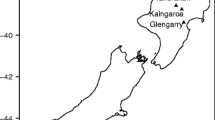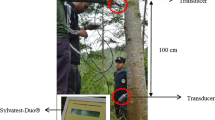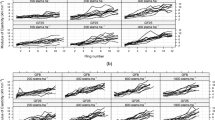Abstract
Tree improvement programs on loblolly pine (Pinus taeda) in the southeastern USA has focused primarily on improving growth, form, and disease tolerance. However, due to the recent reduction of design values for visually graded southern yellow pine lumber (including loblolly pine), attention has been drawn to the material quality of genetically improved loblolly pine. In this study, we used the time-of-flight (TOF) acoustic tool to assess the effect of genetic families on diameter, slenderness, fiber length, microfibril angle (MFA), velocity and dynamic stiffness estimated using green density (DMOEG) and basic density (DMOEB) of 14-year-old loblolly pine stands selected from two sites. All the 184 and 204 trees of the selected eight half-sib genetic families on sites 1 and 2 respectively were tested using TOF acoustic tool, and two 5 mm core samples taken at breast height level (1.3 m) used to for the anatomical and physical properties analysis. The results indicated a significant positive linear relationship between dynamic MOEs (DMOEG and DMOEB) versus tree diameter, slenderness, and fiber length while dynamic MOEs negatively but nonsignificant correlated with MFA. While there was no significant difference in DMOEB between sites; velocity2 for site 1 was significantly higher than site 2 but DMOEG was higher for site 2 than site 1. Again, the mean DMOEG and DMOEB reported in the present study presents a snapshot of the expected static MOE for green and 12% moisture conditions respectively for loblolly pine. Furthermore, there were significant differences between families for most of the traits measured and this suggests that forest managers have the opportunity to select families that exhibit the desired fiber morphology for final product performance. Lastly, since the dynamic MOE based on green density (DMOEG), basic density (DMOEB) and velocity2 present difference conclusions, practitioners of this type of acoustic technique should take care when extrapolating results across the sites.




Similar content being viewed by others
References
ALSC (2013) American Lumber Standard Committee. Board of review board of review minutes. American Lumber Standards Committee, Germantown
Antony F, Schimleck LR, Jordan L, Daniels RF, Clark A (2012) Modeling the effect of initial planting density on within tree variation of stiffness in loblolly pine. Ann For Sci 69:614–650. https://doi.org/10.1007/s13595-011-0180-1
ASTM D2395-2007 (2007) American standard for testing method. Standard test methods for specific gravity of wood and wood-based materials. ASTM International, West Conshohocken. www.astm.org. Accessed 5 Jan 2016
Briggs DG, Thienel G, Turnblom EC, Lowell E, Dykstra D, Ross RJ, Wang XP, Carter P (2007) Influence of thinning on the acoustic velocity of Douglas fir trees in western Washington and Western Oregon. In: Proceedings of the 15th international symposium on nondestructive testing of wood, 10–12 Sept 2007, Duluth, Minnesota-USA, pp 113–123
Carson SD, Dave J, Cown DJ, Russell B, McKinley RB, Moore JR (2014) Effects of site, silviculture and seed lot on wood density and estimated wood stiffness in radiate pine at mid-rotation. N Z J For Sci 44(1):26–37. https://doi.org/10.1186/s40490-014-0026-3
Chan MJ, Walker CJ, Raymond CA (2011) Effect of moisture content and temperature onacoustic velocity and dynamic MOE of radiata pine sapwood boards. Wood Sci Technol 45:609–626. https://doi.org/10.1007/s00226-010-0350-6
Clark A, Jordan L, Schimeleck L, Daniels RF (2008) Effect of initial planting spacing on wood properties of unthinned loblolly pine at age 21. Forest Prod J 58(10):78–83
Dickson RL, Joe B, Harris P, Holtorf S, Wilkinson C (2004) Acoustic segregation of Australian grown Pinus radiata logs for structural board production. Aust For 67:261–266
Dungey HS, Matheson AC, Kain D, Evans R (2007) Genetics of wood stiffness and its component traits in Pinus radiate. Can J For Res 36:1165–1178
Essien C (2011) Physical, Anatomical and Treatment characteristics of the wood of Cola gigantea and Ficus sur. Master of Philosophy Thesis, Submitted to Faculty of Renewable Natural Resource-Kwame Nkrumah University of Science and Technology, Kumasi, Ghana, p 196
Essien C, Cheng QZ, Via BK, Loewenstein EF, Wang XP (2016) An Acoustic operations study for loblolly pine standing saw timber with different thinning history. BioResources 11(3):7512–7521. https://doi.org/10.15376/biores.11.3.7512-7521
Essien C, Via BK, Cheng QA, Gallagher T, McDonald T, Wang XP, Eckhardt LG (2017a) Multivariate modeling of acousto-mechanical response of fourteen year old suppressed loblolly pine (Pinus taeda) to variation in wood chemistry, microfibril angle, and density. Wood Sci Technol 51:475–492. https://doi.org/10.1007/s00226-017-0894-9
Essien C, Via BK, Gallagher T, McDonald T, Eckhardt LG (2017b) Sensitivity of acoustic tools to variation in equilibrium moisture content of small clear samples of loblolly pine (Pinus taeda L.). J Indian Acad Wood Sci. https://doi.org/10.1007/s13196-017-0202-1
FPL (2010) Forest Products Laboratory Wood handbook—wood as an engineering material. General Technical Report FPL-GTR-190. U.S. Department of Agriculture, Forest Service, Forest Products Laboratory, Madison
Gao S, Wang XP, Wang LH, Allison RB (2012) Effect of temperature on the acoustic evaluation of standing trees and logs: part 1—laboratory investigation. Wood Fiber Sci 44(3):286–297
Greenhill AG (1918) Determination of the greatest height consistent with stability that a vertical pole or mast can be made, and of the greatest height to which a tree of given proportions can grow. Proc Camb Philos Soc 4:65–73
Hasegawa M, Takata M, Matsumura J, Oda K (2011) Effect of wood properties on within-tree variation in ultrasonic wave velocity in softwood. Ultrasonics 51(3):296–302
Isik F, Mora CR, Schimleck LR (2011) Genetic variation in Pinus taeda wood properties predicted using non-destructive techniques. Ann Forest Sci 68:283–293. https://doi.org/10.1007/s13595-011-0035-9
Johnson GR, Gartner BL (2006) Genetic variation in basic density and modulus of elasticity of coastal Douglas fir. Tree Genet Genomes 3:25–33
Lachenbruch B, Johnson GR, Downes GM, Evans R (2010) Relationship of density, microfibril angle and sound velocity with stiffness and strength in matured of Douglas fir. Can J For Res 40(1):55–65
Lasserre JP, Mason EG, Watt MS (2005) The effect of genotype and spacing on Pinus radiata [D. Don] corewood stiffness in an 11-year-old experiment. For Ecol Manag 205:375–383. https://doi.org/10.1016/j.foreco.2004.10.037
Lasserre JP, Mason EG, Watt MS (2007) Assessing corewood acoustic velocity and modulus of elasticity with two impact based instruments in 11-year-old trees from a clonal-spacing experiment of Pinus radiata D. Don. For Ecol Manag 239:217–221
Lenz P, Anty D, Achim A, Beaulieu J, Mackay J (2013) Genetic improvement of White Spruce mechanical wood traits—early screening by means of acoustic velocity. Forest 4(3):575–594. https://doi.org/10.3390/f4030575
Li XB, Huber DA, Powell GL, White TL, Perter GF (2007) Breeding for improved growth and juvenile corewood stiffness in slash pine. Can J For Res 37(10):1886–1893. https://doi.org/10.1139/X07-043
McKeand S, Mullin T, Byram T, White T (2003) Deployment of genetically improved loblolly and slash pine in the South. J Forest 101:32–37
Megraw RA, Bremer D, Leaf G, Roers J (1999) Stiffness in loblolly pine as a function of ring position and height, and its relationship to microfibril angle and specific gravity. In: Third workshop-connection between silviculture and wood quality through modeling approaches, La Londeles Maures, France, 1999. IUFRO, pp 341–349
Mora CR, Schimleck LR, Isik F, Mahon JM, Clark A, Daniels RF (2009) Relationship between acoustic variable and different measures of stiffness in standing Pinus taeda trees. Can J For Res 39(8):1421–1429. https://doi.org/10.1139/X09-062
NOAA (2016) National Oceanic and Atmospheric Administration. State, regional and national monthly precipitation: area weighted monthly normal, 1981–2015. Historical Climatography
Olivito RS (1996) Ultrasonic measurements in wood. Mater Eval 54:514–517
Peter GF, Benton DM, Bennett K (2003) A simple direct method for measurement of microfibril angle in single fibers using differential interference contrast microscopy. J Pulp Paper Sci 29:274–280
Raymond CA, Joe B, Anderson DW, Watt DJ (2008) Effect of thinning on relationships between three measures of wood stiffness in Pinus radiata: standing trees vs. short clear specimens. Can J For Res 38(11):2870–2879. https://doi.org/10.1139/X08-124
Roth BE, Li XB, Huber DA, Peter GF (2007) Effects of management intensity, genetics and planting density on wood stiffness in a plantation of juvenile loblolly pine in the southeastern USA. For Ecol Manag 246:155–162. https://doi.org/10.1016/j.foreco.2007.03.028
SAS Institute (2014). Statistical Analysis Software version 9.4 Cary, NC, USA
Via BK (1998) Relationship between tooth withdrawal strength and specific gravity for metal plate truss connection. MS thesis submitted to Virginia Polytechnic Institute and State University, p 96
Via BK, So CL, Shupe TF, Groom LH, Wikaira J (2009) Mechanical response of longleaf pine to variation in microfibril angle, chemistry associated wavelengths, density and radial position. Compos A 40(1):60–66
Vikram V, Cherry ML, Briggs D, Cress DW, Evans R, Howe GT (2011) Stiffness of Douglas-fir lumber: effect of wood properties and genetics. Can J For Res 41(6):1160–1173
Wang XP (2013) Acoustic measurement on trees and logs: a review and analysis. Wood Sci Technol 47(5):965–975
Wang XP, Ross RJ, McClellan M, Barbour RJ, Erickson JR, Forsman JW, McGinnis GD (2001) Nondestructive evaluation of standing tree with a stress wave method. Wood Fiber Sci 33(4):522–533
Wang XP, Ross RJ, Brashaw BK, Punches J, Erickson JR, Forsman JW, Pellerin RE (2004) Diameter effect on the stress-wave evaluation of modulus of elasticity of logs. Wood Fiber Sci 36(3):368–377
Wang XP, Ross RJ, Carter P (2007) Acoustic evaluation of wood quality I standing tree. Part 1: acoustic behavior in standing tree. Wood Fiber Sci 39(1):28–38
Acknowledgements
The materials for the study were supplied by the Auburn University Forest Health Cooperation. We appreciated the technical and logistical support from students and staff of Forest Health Dynamics Laboratory and Forest Products Development Center of Auburn University.
Author information
Authors and Affiliations
Corresponding author
Additional information
Project funding: The work was supported by the Auburn University Intramural funds.
The online version is available at http://www.springerlink.com
Corresponding editor: Tao Xu.
Rights and permissions
About this article
Cite this article
Essien, C., Via, B.K., Acquah, G. et al. Effect of genetic sources on anatomical, morphological, and mechanical properties of 14-year-old genetically improved loblolly pine families from two sites in the southern United States. J. For. Res. 29, 1519–1531 (2018). https://doi.org/10.1007/s11676-017-0584-3
Received:
Accepted:
Published:
Issue Date:
DOI: https://doi.org/10.1007/s11676-017-0584-3




